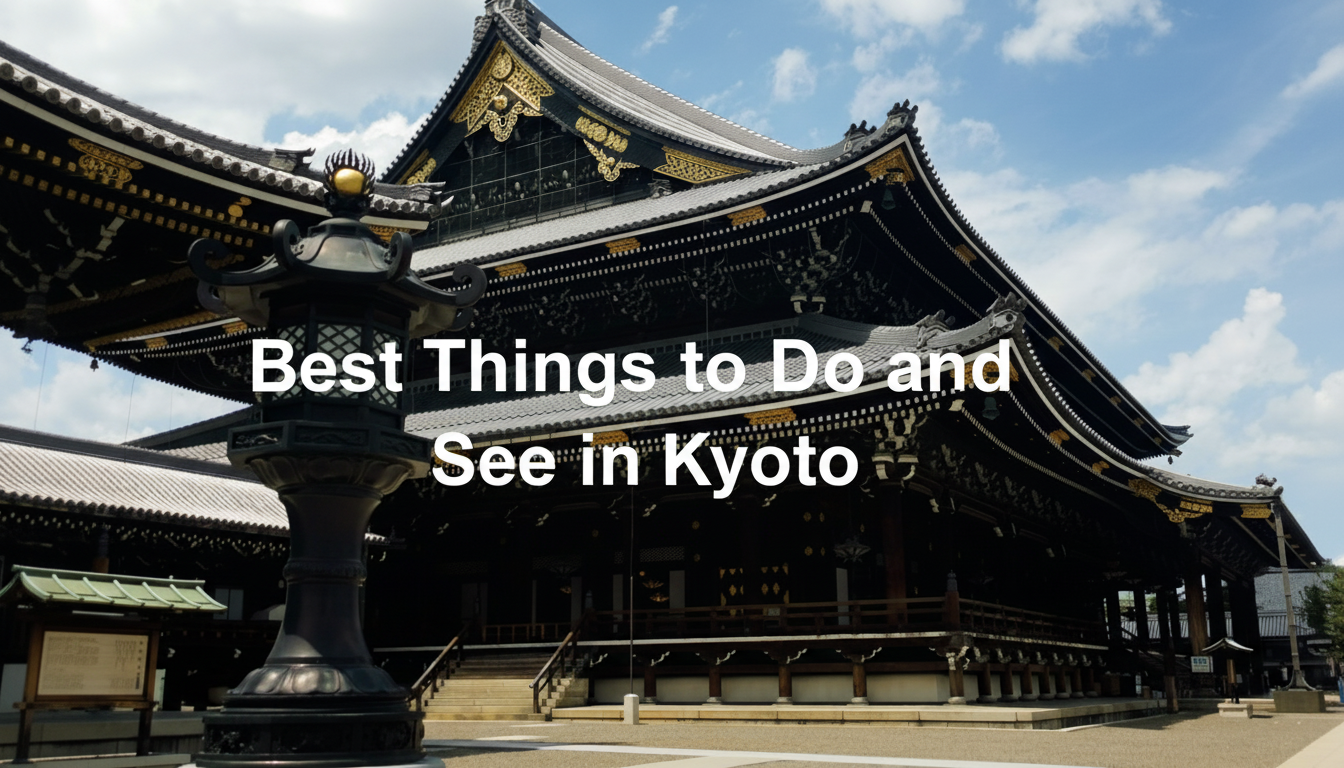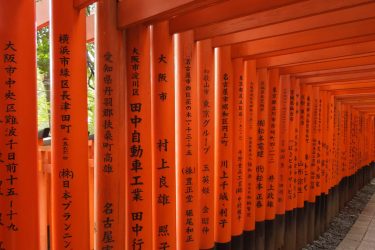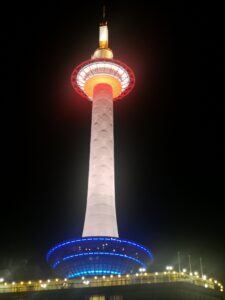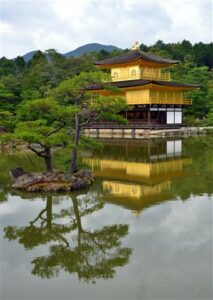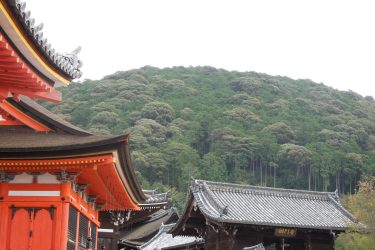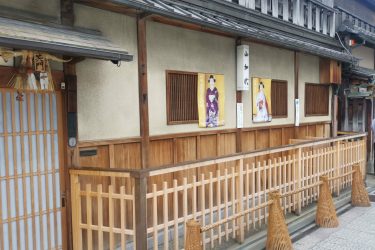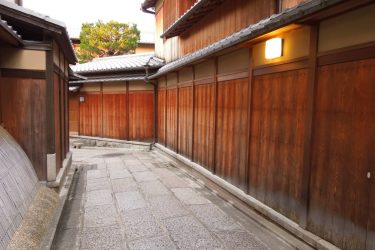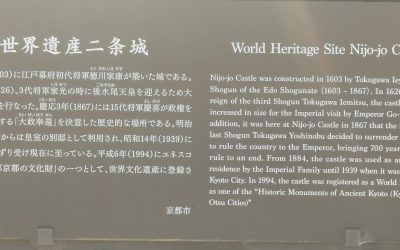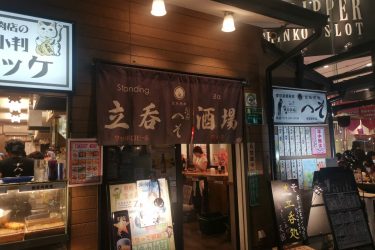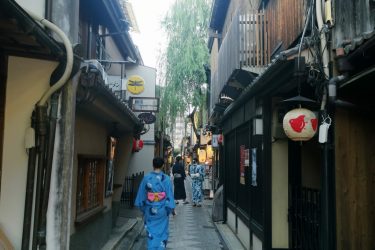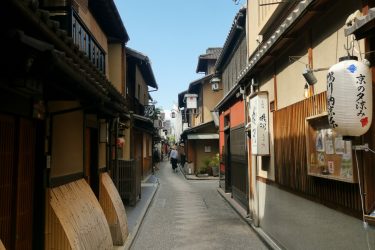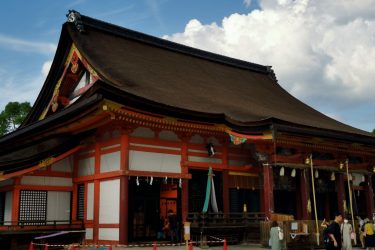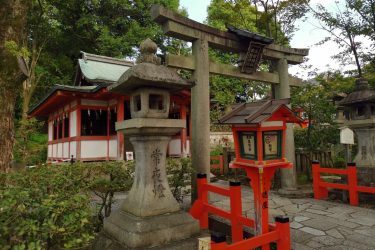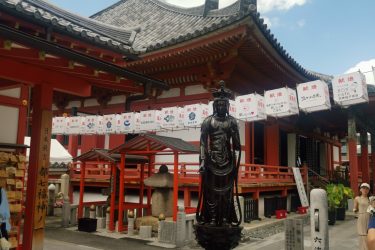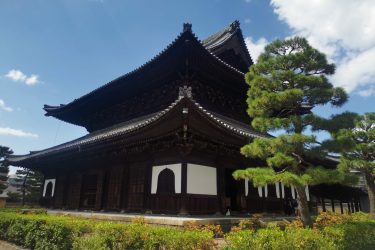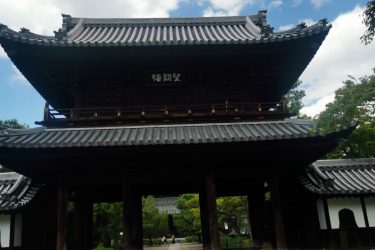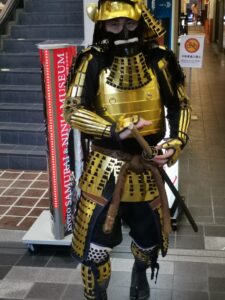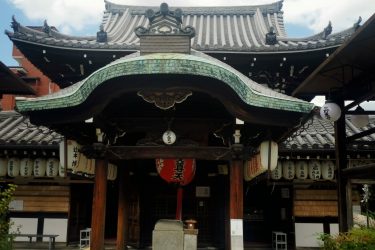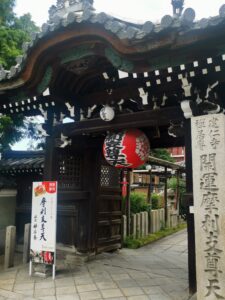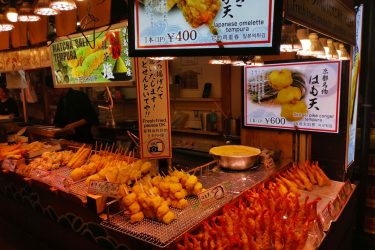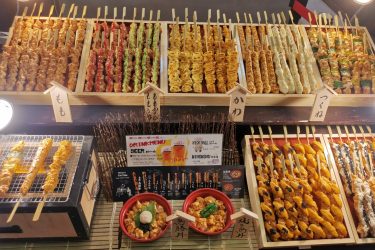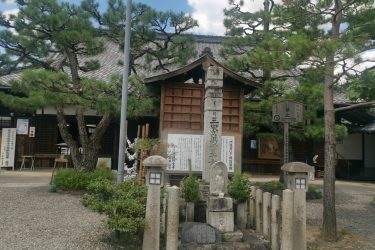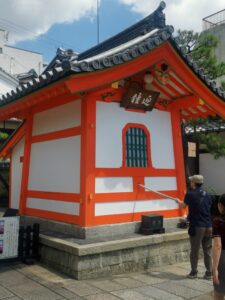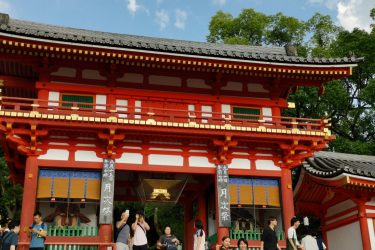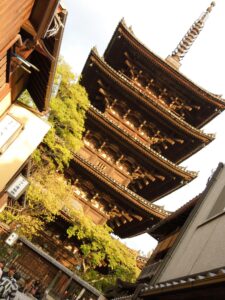Traveling to Kyoto is a captivating experience that fully immerses visitors in the natural beauty, rich history, and culture of Japan. Kyoto, often referred to as the cultural center of Japan, is a must-visit location for any visitor to the country since it provides a distinctive fusion of traditional customs and contemporary amenities.
Historical Landmarks: The renowned Kiyomizu-dera Temple, Kinkaku-ji (the Golden Pavilion), and Ginkaku-ji (the Silver Pavilion) are just a few of Kyoto’s many UNESCO World Heritage sites. These well-known sites highlight Kyoto’s past’s remarkable architectural and historical value. Walking through the holy mountaintop is a captivating experience at Fushimi Inari Shrine, which is adorned with thousands of crimson torii gates.
Customs: The city is a dynamic exposition of traditional Japanese customs. Explore the historic Gion neighborhood, which is well-known for its wooden machiya residences and geisha culture. Kyoto’s cultural legacy can be better understood by taking part in a traditional tea ceremony, seeing a Noh or Kabuki performance, or going to a festival like Gion Matsuri.
Gardens and Nature: Kyoto’s natural splendor is equally enthralling. The Philosopher’s trail is a charming trail dotted with flowering sakura trees, especially during cherry blossom season. The Arashiyama Bamboo Grove offers a tranquil strolling path surrounded by towering bamboo stalks. Traditional Japanese gardens in Kyoto, including those at Ryoan-ji and Saiho-ji (the Moss Temple), offer peaceful spaces for contemplation and rest.
Kyoto’s cuisine is a culinary delight that will delight your senses. The city is well-known for its matcha (green tea) desserts, tofu dishes, and kaiseki (traditional multi-course feast). Known as “Kyoto’s Kitchen,” Nishiki Market is a lively marketplace where guests may enjoy fresh food and local specialties.
Attractions for Modern Visitors: Kyoto welcomes modernity despite its rich historical legacy. The Kyoto Railway Museum and the Kyoto International Manga Museum are excellent resources for learning about modern Japanese technology and culture.
Kyoto is a place that is genuinely unforgettable because it offers a diverse range of experiences, including historical exploration, cultural immersion, breath-taking natural beauty, and delectable cuisine. In this article, we will give you our suggestions on what to do and see when you visit Kyoto.
Visit Fushimi Inari Shrine in Kyoto
An enthralling experience that fully immerses guests in Japan’s rich cultural and spiritual legacy is visiting Fushimi Inari Shrine. This Shinto shrine in Kyoto is well-known for the thousands of vivid red torii gates that form an enchanting and memorable scene.
Famous Torii Gates: The thousands of torii gates that border the paths leading to the holy Mount Inari are the main attraction of Fushimi Inari Shrine. These gates, which have been given by people or organizations, produce an amazing tunnel-like effect. It seems as though tourists are entering a different universe when they pass past the gates. There are several smaller shrines and beautiful vistas along the roughly 4-kilometer trek that leads to the summit, which hikers can complete in two hours.
Historical Significance: Fushimi Inari Shrine was established in the early eighth century and is devoted to Inari, the Shinto deity of agriculture and rice. Both residents and visitors to the shrine, a prominent religious location, come to ask for blessings for success and happiness. The shrine complex features numerous fox statues scattered throughout the grounds, symbolizing the creatures that are thought to be Inari’s messengers.
The Main Shrine: Located at the foot of the mountain, Fushimi Inari-taisha is the main shrine. It has a spacious courtyard and a majestic entrance. The main hall offers insight into Shinto architecture and ceremonies with its elaborate carvings and vivid colors.
Seasonal Beauty: Springtime cherry blossoms and brilliant fall foliage provide stunning settings for the shrine, which is lovely all year long. Before the hordes gather, early morning visits offer a peaceful setting.
Cultural Experiences: Japanese snacks and souvenirs from the different stalls along the shrine’s approach can be enjoyed by tourists in addition to seeing the gates and shrines. The serene and spiritual atmosphere provides an ideal setting for introspection and admiration of Japan’s scenic and cultural treasures.
A trip through the breath-taking scenery of spiritual importance and architectural beauty that offers a unique window into Japanese culture and the Shinto faith is what it means to visit Fushimi Inari Shrine.
Visit Kyoto Tower in Kyoto
Kyoto Tower is a well-known landmark with stunning views of Kyoto and the surrounding area from its 131-meter height. This contemporary building, which is close to Kyoto Station, stands in stark contrast to the city’s traditional atmosphere and offers a special viewpoint for appreciating both the old and new parts of the city.
Observation Deck: Kyoto Tower’s observation deck, which provides a broad perspective of the city’s cityscape, including the Kiyomizu Temple and the far-off mountains, is its main feature. On clear days, guests may take in the vast vistas of the surrounding countryside and as far as Osaka. The deck is especially mesmerizing at dusk and at night when the city lights form a glittering display.
Architectural style: The tower has an exquisite and modern style with a sleek white façade and a red and white top. It was finished in 1964 and features a fusion of traditional and modern Japanese design elements.
Services and Dining: In addition to housing a range of services, the tower also has a souvenir shop and a restaurant serving a selection of Japanese and international dishes. The panoramic windows of the restaurant let patrons take in the scenery while they eat.
A visit to Kyoto Tower offers a singular viewpoint of the city and a remarkable experience of its varied terrain from an incredibly contemporary vantage point.
Explore Kinkaku-ji (The Golden Pavilion) in Kyoto
Discovering Kinkaku-ji, popularly referred to as The Golden Pavilion, is an enchanting experience that provides an insight into Kyoto’s rich architectural and cultural legacy. Officially known as Rokuon-ji, this famous Zen Buddhist temple is well-known for its gorgeous golden façade and tranquil surrounds.
Architectural marvel: Kinkaku-ji’s glittering gold leaf facade, which spans the top two stories of the three-story building, is its most outstanding feature. It was subsequently transformed into a Zen temple after being constructed in the fourteenth century as the shogun Ashikaga Yoshimitsu’s retirement home. The building is a work of architectural art because it combines luxurious features with traditional Japanese aesthetics.
Scenic Beauty: Kinkaku-ji offers stunning vistas that shift with the seasons. It is situated amid an expertly designed garden and reflects in the pond’s mirror-like surface. The golden pavilion is most striking in the fall when it is encircled by vibrant foliage, and it makes a lovely contrast when covered in snow in the winter.
Experience the local culture by taking a leisurely stroll around the lovely gardens, exploring the nearby temple premises, and indulging in tea at the on-site tea house. A tiny museum with displays about the history and restoration of Kinkaku-ji is also present at the location.
Discovering Kinkaku-ji is a serene and breath-taking experience that highlights the synergy between traditional Japanese architecture and the surrounding natural beauty.
Wander Through Arashiyama Bamboo Grove in Kyoto
The Arashiyama Bamboo Grove immerses visitors in a lush, surreal forest of towering green stalks, providing a peaceful and enthralling experience. Situated in Kyoto’s Arashiyama neighborhood, this well-known bamboo forest provides a distinctive window into the serene surroundings and stunning scenery of Japan.
Enchanted Pathways: The Arashiyama Bamboo Grove welcomes you with a towering canopy of bamboo that produces an enchanting visual impact. There are tiny, twisting walkways with dense bamboo that rustles gently in the breeze, creating a calming sound. The forest’s ethereal allure is enhanced by the way light and shadow interact with the stalks of bamboo.
Scenic Beauty: The grove is especially lovely in the early morning or late afternoon when the wonderful glow created by the light passing through the bamboo is intensified. A welcome diversion from the bustle of the city is offered by the quiet, shaded setting. The grove’s natural splendor is a never-ending source of inspiration for photographers and wildlife enthusiasts alike.
Other Attractions in the Area: The Arashiyama district is home to the Tenryu-ji Temple, a UNESCO World Heritage site with lovely grounds, and the charming Togetsukyo Bridge that crosses the Hozu River. These attractions are in addition to the bamboo grove. You may see wild monkeys in their native habitat at the neighboring Iwatayama Monkey Park.
Experience Cultural: As you meander around the grove, pause to consider the bamboo’s cultural significance in Japanese tradition. The serene ambiance of the grove embodies the qualities of resilience and purity, which are commonly linked to bamboo.
Discovering the Arashiyama Bamboo Grove is a serene and breath-taking experience that provides a deeper understanding of Japan’s cultural landscape as well as a special connection with nature. For those seeking solitude or just taking in the breath-taking surroundings, the bamboo grove offers an unforgettable getaway into Kyoto’s captivating landscape.
Discover Kiyomizu-dera Temple in Kyoto
Exploring Kiyomizu-dera Temple is like taking a trip through the center of Kyoto’s intricate historical and cultural fabric. Established in 778, this historic Buddhist temple is a UNESCO World Heritage site and one of Japan’s most well-known attractions.
Kiyomizu-dera: is known for its magnificent main hall, which protrudes over the hillside and is held up by hundreds of wooden pillars. Beautiful views of Kyoto and the surrounding hillsides may be seen from this stage-like veranda, which are particularly striking in the springtime when cherry blossoms bloom and in the fall when the foliage is colorful.
Otowa Waterfall: The Otowa Waterfall, which flows beneath the main hall of the temple, is the source of the temple’s name, which translates to “Pure Water Temple.” Its three streams, each purported to bestow a distinct blessing—longevity, academic success, and good love—are available for consumption by guests. That being said, it is deemed avaricious to sip from all three.
Cultural Significance: Kannon, the goddess of mercy, is honored in this shrine. The Jishu Shrine, which honors the god of love and marriage, is one of the complex’s halls and shrines that highlights its spiritual significance. Oftentimes, guests come to pray for relationship blessings.
Beautiful Pathways: The route to Kiyomizu-dera, dotted with vintage stores and tea houses, enhances the sense of immersion. The investigation of local crafts, souvenirs, and confections is enhanced for visitors.
Kiyomizu-dera Temple is a must-see location in Kyoto because it provides a diverse range of historical, spiritual, and natural experiences.
Stroll Through the Gion District in Kyoto
Walking around Kyoto’s Gion District is like taking a trip back in time to discover the grace and charm of traditional Japan. Gion has a distinct and enthralling environment. It is well-known for its traditional wooden machiya residences, teahouses, and geisha culture.
Historical Ambiance: The well-preserved machiya, or old wooden townhouses, adorn Gion’s winding cobblestone lanes, transporting tourists back in time to the Edo era. Numerous of these structures are currently used as posh eateries, tea rooms, and stores; they still have their antique charm but with contemporary conveniences.
Geisha Culture: Gion is particularly well-known for its geisha, or geiko as they are called in the area, and their apprentices, or maiko. During the evening, visitors can observe these sophisticated women go to their appointments, wearing their unique kimonos and sporting exquisite haircuts. You can get a closer look at this elegant cultural art form by scheduling a private tea ceremony or going to a traditional performance at Gion Corner.
Yasaka Temple: Standing over 1,350 years old, Yasaka Shrine is a bustling, lively Shinto temple located in the center of Gion. Held in July, the Gion Matsuri is a renowned event in Japan with this as its central feature. A calm place to unwind and take in the spiritual atmosphere is the shrine’s lantern-lit grounds.
Hanami-koji Street: is the main thoroughfare in Gion, known for its exquisitely maintained architecture and upscale tea shops that host geiko and maiko performances. A beautiful perspective of traditional Kyoto can be had by strolling through Hanami-koji.
Kyoto’s cultural heritage can be fascinatingly experienced by strolling around the Gion District, which offers a unique fusion of modern custom and ancient elegance.
Visit Ishibe Alley in in Kyoto
One of Kyoto’s most enchanting and attractive lanes, Ishibe Alley, also known as Ishibei-koji, provides a peaceful window into the city’s past. This little, stone-paved alley, tucked away in the Higashiyama neighborhood, is dotted with exquisitely preserved ancient wooden machiya dwellings, giving the impression that you are traveling back in time.
Historical Charm: The Edo-period architecture of Ishibe Alley is well known for having been conserved. Japanese design is exemplified by the machiya, ancient timber mansions with sliding doors and elaborate latticework. Visitors can enjoy the peaceful and visually appealing atmosphere created by the artful blending of wood, stone, and paper as they stroll through the lane.
Calm Ambience: Ishibe Alley provides a calmer, more serene atmosphere than the bustling streets of Gion and other well-known tourist destinations. The absence of contemporary encroachments, such power lines and neon signs, permits guests to completely lose themselves in the ambiance of the past. This makes it the ideal location for leisurely walks and taking pictures.
Cultural insights: A few ryokan, or traditional Japanese inns, and premium restaurants serving kaiseki, or traditional multi-course Japanese meals, may be found in the alley. A genuine flavor of Kyoto’s rich cultural past can be had by visiting or dining at one of these venues. The great dining experience, exquisite décor, and attentive service all offer a window into the affluent way of life in bygone Kyoto.
Ishibe Alley is well situated in relation to other important sites, like Kodaiji Temple and Yasaka Shrine, which makes it a great place to start a sightseeing day or a tranquil diversion.
Visit Nijo Castle in Kyoto
Traveling back in time to Japan’s feudal era and seeing the interesting glimpses into the shoguns’ lives and rich architectural legacy may be had by visiting Nijo Castle in Kyoto. Known for its historical significance and superb design, this UNESCO World Heritage site was built in 1603 by Tokugawa Ieyasu, the first shogun of the Edo era.
Historical Significance: The Tokugawa shoguns lived in Nijo Castle in Kyoto. The last shogun, Tokugawa Yoshinobu, ended Japan’s feudal era here in 1867 by giving the emperor back imperial authority. The castle is a representation of the Tokugawa shogunate’s authority and stature.
Architectural marvels: The Ninomaru Palace and the Honmaru Palace are the two concentric rings of defenses that make up the castle complex. The “nightingale floors” of the Ninomaru Palace are especially well-known for their squeaking sound that warns occupants of potential invaders. Exquisite wood carvings and breath-taking fusuma (sliding door) paintings of the Kano school, which show scenes of landscapes, flowers, and animals, adorn the palace’s exquisitely furnished interiors.
Gorgeous Gardens: Meticulously kept gardens encircle the palaces. Renowned landscape architect Kobori Enshu created the Ninomaru Garden, which reflects the ideas of traditional Japanese garden design with its vast pond with islands and thoughtfully placed stones and plants.
Cultural Experience: Seasonal events and exhibitions showcasing Nijo Castle’s artistic and historical value offer a rich cultural experience. Explore the castle grounds, take in the architectural intricacies, and see educational displays on the Edo period.
Nijo Castle is a must-see location in Kyoto because it combines historical intrigue, stunning architecture, and serene gardens to create an enthralling experience.
Nightlife in Kyoto
Kyoto’s nightlife offers a distinctive fusion of traditional and modern experiences that are a reflection of the city’s modern metropolitan lifestyle and rich cultural legacy. Even though Kyoto does not get as busy as Tokyo or Osaka at night, it nevertheless has a unique appeal and a wide range of things to do.
Pontocho Alley: One of the most well-known areas of Kyoto for nightlife is Pontocho Alley, a small alleyway surrounded by traditional wooden machiya homes. A variety of expensive kaiseki (multi-course) restaurants, welcoming izakayas (Japanese pubs), and chic bars can be found here. A great dining experience can be had by setting up temporary decks (noryoyuka) along the Kamogawa River, particularly in the summer.
Gion District: Renowned for its classic teahouses and geisha customs, Gion becomes a calm yet energetic neighbourhood after dark. Luxurious dining establishments are open to guests, who can also take advantage of traditional performances by geiko (Kyoto geisha) and maiko (apprentice geisha). Gion’s lantern-lit streets provide an insight into traditional Japan.
Kiyamachi Street: Running parallel to Pontocho, this charming canal side street is dotted with a variety of eateries and bars. With its variety of bars, pubs, and nightclubs, this region appeals to a younger clientele. It is a great place to visit different bars and take in the vibrant environment.
Nishiki Market: Mostly a daytime market, Nishiki Market also has some evening hours when it is open and serves street cuisine and regional specialties. It is a terrific place to enjoy casual dining while sampling some of Kyoto’s culinary pleasures.
Live Music and Theaters: For individuals who are interested in cultural activities, Kyoto also has theatres and live music venues. Traditional kabuki performances take place in places like Kyoto MINAMI-ZA Theatre, while live jazz, rock, and traditional music performances take place in smaller clubs and pubs.
Night Temples & Shrines: During specific seasons of the year, some temples and shrines, like as Kiyomizu-dera and Fushimi Inari Taisha, have unique nocturnal illuminations that offer a calming and enchanted experience.
Kyoto’s nightlife is a delightful fusion of the ancient and the modern, with options to suit all tastes and a riveting way to take in the city’s distinct ambience after dark.
Festivals in Kyoto
Kyoto is well known for its rich historical and cultural legacy. The city also hosts a number of colorful festivals that highlight its customs and sense of community. The following are some of Kyoto’s most well-known festivals:
Gion Matsuri: One of the most well-known festivals in Japan is Gion Matsuri, which takes place during the month of July. It was first held in the ninth century to placate the gods after a plague. The celebration includes traditional music, performances, and huge parades of intricately adorned floats known as yamaboko. The climax is the July 17 and 24 Yamaboko Junko parade, when floats are hauled through Kyoto’s streets, producing an amazing and vibrant ambiance.
Aoi Matsuri: One of Kyoto’s three main festivals is Aoi Matsuri, which is observed on May 15. Those dressed in Heian period costumes participate in a magnificent parade from the Imperial Palace to the Kamo Shrines as part of the celebration. The hollyhock (aoi) leaves that decorate the costumes and floats are the festival’s namesake, signifying its historical roots in customs meant to assure a bountiful harvest.
Jidai Matsuri: Also known as the Festival of Ages, this event honours Kyoto’s lengthy past and is held on October 22. The procession, which covers more than a millennium and includes individuals dressed in clothes from the Heian period to the Meiji Restoration, is the main event. The parade, which offers an engrossing voyage through Japanese history, begins at the Imperial Palace and concludes at Heian Shrine.
Gozan no Okuribi: This event, which takes place on August 16, signifies the conclusion of the Obon season, during which the ancestors’ spirits pass into eternity. Massive bonfires, shaped like the well-known “Daimonji” character, are ignited a top five mountains that encircle Kyoto. Daimonji, another name for this event, is a captivating sight that evokes a profoundly spiritual atmosphere.
Arashiyama Hanatouro: This mid-December celebration turns the Arashiyama neighborhood into a wintry paradise. The streets are lined with thousands of lanterns, and traditional events take place by the famous Togetsukyo Bridge and in the bamboo forests. The encounter is remarkable because of the calm and entrancing atmosphere.
These festivals in Kyoto are vital because they provide a special chance to encounter the city’s ingrained customs, lively sense of community, and historical significance.
11. Visit the Fascinating Pontocho-dori Street Area in Kyoto
Kyoto’s quiet, charming Pontocho-dori is one of the most well-known and culturally diverse districts in the city. Between Shijo-dori and Sanjo-dori, Pontocho runs parallel to the Kamo River and is well-known for its traditional wooden machiya residences, real eating experiences, and fascinating look into Kyoto’s past.
Traditional Atmosphere: Pontocho-dori exudes a timeless elegance. The street is dotted with exquisitely kept wooden structures that are home to a variety of eateries, tea rooms, and traditional businesses. You can almost feel the echoes of bygone eras when Pontocho was a bustling entertainment district frequented by samurais and geishas as you meander along the lantern-lit street.
Culinary Delights: For those who enjoy good food, Pontocho is a haven. There are many different places to eat along the street, ranging from upscale kaiseki (traditional multi-course meals) restaurants to more laid-back izakayas and yakitori establishments. Numerous eateries have seating along the Kamo River, providing gorgeous views that are especially charming in the summer when noryo-yuka, or outdoor dining, is popular.
Geisha Culture: Kyoto has several hanamachi, or geisha districts, including Pontocho. Though not as commercialized as Gion, Pontocho still provides visitors with the opportunity to see maiko, or apprentice geishas, or geiko, as they go to evening appointments. This uncommon sight heightens the enchanted ambiance by lending it a sense of mystery and tradition.
Seasonal attractiveness: Pontocho’s attractiveness varies according to the season. Autumn delivers vivid red and orange foliage, while cherry blossoms in April give the landscape a delicate pink tone. The street’s charm is enhanced by the changing of the seasons, drawing both residents and visitors.
Entertainment and Nightlife: With its cozy lanes lit by lanterns and the sounds of animated conversations, Pontocho comes alive at night. There are several pubs and entertainment establishments in the area, offering a chic yet laid-back evening.
Cultural Experiences: In addition to dining, Pontocho provides an immersive look into Kyoto’s rich cultural legacy with events including traditional tea ceremonies and performances by geishas and maikos.
A trip down memory lane to Pontocho-dori, where modernity and tradition collide, is a must-do experience while in the center of Kyoto.
12. Visit the Yasaka Shine in Kyoto
One of the most well-known and historically significant Shinto temples in Kyoto is Yasaka Shrine, sometimes referred to as Gion Shrine. Yasaka Shrine, a thriving center of religion and culture, is situated at the eastern end of Shijo-dori, close to the busy Gion neighborhood. It attracts tourists all year long with its beautiful building, calm environment, and participation in Kyoto’s major festivities.
Historical Significance: Yasaka Shrine has a long history in Kyoto, having been founded more than 1,350 years ago. It has long been a hub of the city’s spiritual life and a site of worship for the local populace. The shrine honors the god of storms and the sea, Susanoo-no-Mikoto, along with his bride Kushinadahime and eight of his progeny deities
Architectural Beauty: With its vivid vermillion gates (torii), elaborate wooden carvings, and thatched roofs, the shrine’s architecture is a superb illustration of traditional Shinto style. Particularly remarkable are the main hall (honden) and offering hall (haiden), which exhibit the grace and minimalism typical of Shinto aesthetics.
Gion Matsuri: Yasaka Shrine is primarily known for being the starting site of Japan’s most well-known festival, the Gion Matsuri, which takes place in July. This month-long celebration draws tourists from all over the world with its intricate floats, processions, and traditional performances. The event, which has been celebrated since the 9th century, honors Yasaka Shrine’s contribution to defending Kyoto against natural calamities and diseases.
Seasonal Beauty: Yasaka Shrine is a well-liked location year-round, but especially during the spring cherry blossom season and the brilliant fall foliage. The grounds of the shrine are covered in vibrant maples and cherry trees that are in full bloom, making for a serene walk.
Maruyama Park: Known for its hanami (watching cherry blossoms) and leisure activities, Maruyama Park is located next to Yasaka Shrine. The main feature of the park is a big weeping cherry tree, which attracts a lot of attention from tourists in the spring.
Spiritual Experience: In the center of Kyoto, Yasaka Shrine provides a haven for spirituality that goes beyond its historical and cultural value. Many come to pray for prosperity, health, and good fortune; they often leave contributions and buy omamori, or protection charms, as mementos of their trip.
Yasaka Shrine is a must-visit location for everybody visiting Kyoto since it offers a unique fusion of spirituality, culture, and history.
13. Visit the Rokuharamitsuji Temple in Kyoto
Nestled in Kyoto’s Higashiyama neighborhood, Rokuharamitsuji Temple is a venerable Buddhist temple steeped in spiritual significance and cultural legacy. One of Kyoto’s lesser-known gems, Rokuharamitsuji was founded in 963 by the priest Kuya, who is credited with popularizing Pure Land Buddhism in Japan. It provides a tranquil haven away from the busier attractions of the city.
Historical Significance: One of Kyoto’s earliest temples, Rokuharamitsuji was instrumental in the spread of Pure Land Buddhism. The founder of the temple, Kuya, was a dynamic man well-known for his unceasing efforts to disseminate Buddhist teachings among the general public. The name of the temple, which means “Six Virtues Temple,” alludes to the six perfections, or paramitas, that are essential to Mahayana Buddhism.
Architectural Beauty: With its calm, uncomplicated lines and quiet ambiance, the temple’s main hall, Hondo, is a magnificent example of traditional Japanese temple architecture. Within is a statue of Kuya, also known as Kuya Shonin, who is shown singing the nembutsu, a mantra that invokes the name of Amida Buddha. Six little sculptures of Amida Buddha emerge from his mouth, signifying the teachings’ power.
Art and Treasures: Important cultural treasures, including as statues recognized as Important Cultural Properties, may be found at Rokuharamitsuji. One of these is the statue of Avalokiteshvara, also known as the Eleven-Faced Kannon, a compassionate deity who is a focal point of various Buddhist traditions.
Spiritual Significance: The temple is a highly spiritual location that draws pilgrims and guests who come to offer prayers for safety, well-being, and tranquility. Its serene surroundings, isolated from the rush of contemporary life, provide a place for meditation and introspection.
Relation to Historical Persons: Rokuharamitsuji is also connected to the Taira clan, which was one of the strongest in Heian Japan. The temple is intimately associated with the history of the Genpei War, a pivotal battle in Japanese history, and functioned as a haven for clan members following their collapse.
A visit to Rokuharamitsuji Temple is a peaceful and meaningful experience that sheds light on Kyoto’s religious and cultural heritage. For those looking to gain a deeper grasp of Japan’s cultural legacy, it is a must-visit location where history, art, and spirituality all come together.
14. Hop on Hop off Bus Tours in Kyoto
In Kyoto, hop-on-hop-off bus tours provide an easy and adaptable method to discover the city’s historical landmarks, abundant cultural legacy, and breath-taking scenery. These excursions cater to both first-time tourists and those who want to experience the best of Kyoto quickly, all while having the flexibility to see each location at their own leisure.
Convenience and Flexibility: Convenience is one of the key benefits of taking a Hop-on Hop-off bus trip. With these tours, you can take a thorough route that covers the main sights in the city, get off at any scheduled stop, explore the area, and then board the next bus when you’re ready to go again. Travelers who like to see as much as possible without the bother would love this freedom.
Major Attractions Covered: The Hop-on Hop-off buses in Kyoto usually stop at important sites such the Gion neighborhood, Fushimi Inari Shrine, Kinkaku-ji (the Golden Pavilion), Kiyomizu-dera Temple, and Nijo Castle. This relieves travelers of the burden of organizing their trip to these must-see locations. The buses frequently travel along routes that provide picturesque views of Kyoto’s verdant hills, customary communities, and ancient temples.
The majority of Hop-on Hop-off bus excursions come with guided commentary in many languages, either through audio guides or live commentary. These services offer insightful information about the history, culture, and significance of each destination. This educational component enriches the experience and gives guests a better knowledge of Kyoto’s rich history.
Time Efficiency: A Hop-on Hop-off bus tour is an effective method to get the most of your sightseeing if you’re short on time. You don’t have to rush to arrange your day around particular stops because the buses operate on regular times. Furthermore, the trips frequently grant access to other routes, providing a comprehensive perspective of the city.
Comfort and Accessibility: Kyoto’s Hop-on Hop-off buses provide cosy seating and frequently offer open-top alternatives that provide stunning city views. They guarantee that everyone can enjoy the tour, even those who have limitations.
In conclusion, Hop-on Hop-off bus tours in Kyoto offer a convenient, educational, and pleasurable method to view the city’s famous sights, making them a great option for visitors looking for a thorough and adaptable sightseeing experience.
15. Visit the Kenninji Temple in Kyoto
Nestled in Kyoto’s historic Gion area, Kenninji Temple is among the oldest and most prominent Zen Buddhist temples in the city. Established in 1202, the quiet and contemplative Kenninji Temple provides guests with a profound link to Kyoto’s religious and cultural legacy. Eisai, the monk, was responsible for introducing the Rinzai branch of Zen Buddhism to Japan.
Historical Significance: It is frequently believed that Zen Buddhism originated in Kenninji, Japan. The founder of the temple, Eisai, studied Buddhism in China and returned with Zen teachings as well as the custom of drinking tea, which became ingrained in Japanese culture. The temple has had a significant impact on the growth of Zen practice and has shaped many facets of Japanese spirituality, art, and society.
Architectural Beauty: The temple complex’s straightforward, tasteful structures are artfully woven into the surrounding gardens, making it a magnificent example of Zen architecture. The Hojo, or abbot’s quarters, is especially noteworthy for its serene ambiance and simple style. The iconic “Twin Dragons” ceiling mural in the Dharma Hall is one of the temple’s well-known gardens, which is intended to promote introspection and meditation.
Artistic Treasures: Renowned Zen monks and artists have left their mark on Kenninji through their paintings and calligraphy, among other significant cultural artefacts. The “Fujin Raijin-zu,” a pair of folding screen paintings by renowned artist Tawaraya Sōtatsu that represent the gods of wind and thunder, are among the temple’s most well-known features.
Zen Experience: Guests at Kenninji can take part in zazen meditation sessions, which offer an up-close look at the spiritual activities of the temple. These classes provide a special chance to learn about Zen Buddhism, which places a strong focus on inner calm, simplicity, and mindfulness.
Seasonal Beauty: The springtime cherry blossom season and the fall foliage shift are two of Kenninji’s most gorgeous times of year. The lush vegetation and well-kept gravel of the temple’s grounds provide a peaceful respite from Gion’s bustling streets.
A profound and serene experience, a visit to Kenninji Temple enables guests to establish a connection with Kyoto’s spiritual center and to understand the long-lasting influence of Zen Buddhism on Japanese culture.
16. Visit he Samurai and Ninja Museum in Kyoto
Discover the fascinating world of Japan’s famed warriors with an immersive and instructive experience at the Samurai and Ninja Museum in Kyoto. This museum, which is centrally located, offers tourists a rare chance to discover more about the customs, history, and culture of the ninja and samurai—two of Japan’s most recognizable and mysterious groups.
The museum is well-known for its interactive displays that let visitors experience with the ninja and samurai civilizations up close. Engaging in interactive activities like as sword-handling demonstrations, ninja star tossing, and trying on authentic samurai armour and ninja costumes brings history to life in an enjoyable and unforgettable manner.
Historical Perspectives: The museum explores the roles played by samurai and ninja in Japanese society while providing in-depth explanations of their origins and development. In addition to learning about the ninja’s cunning strategies, espionage, and survival abilities, visitors may also learn about the samurai code of honor, or Bushido, which placed an emphasis on discipline, loyalty, and martial prowess. The museum offers a comprehensive perspective on the ways in which these warriors influenced Japanese history and culture.
Genuine Artefacts: The museum’s collection of genuine samurai swords, armor, and other historical relics is one of its main attractions. These artefacts demonstrate the elaborate patterns and practical features of the armor and weaponry wielded by these fearsome fighters, providing an insight into the period’s workmanship and artistry.
Cultural Performances: Visitors can watch these ancient arts in action as the museum often organizes live demonstrations of ninja and samurai swordsmanship (kenjutsu). Not only are these shows fascinating, but they also help viewers gain a greater understanding of the ability and discipline needed by ninjas and samurai.
Educational Workshops: The museum offers workshops on swordsmanship, meditation, and other traditional practices for individuals who want to go further. These classes offer a genuine experience and a deeper understanding of the ideologies and methods of Japan’s warrior traditions.
Anyone interested in Japan’s martial traditions must visit the Samurai and Ninja Museum in Kyoto. Offering guests a rare window into the realm of Japan’s famed warriors, it is an entertaining and educational experience that vividly brings the illustrious history of samurai and ninja to life.
17. Visit the Zenkyo-an Temple in Kyoto
Kyoto’s Zenkyo-an Temple is a little-known treasure that provides a calm and personal window into Japanese Zen Buddhism. Zenkyo-an is less crowded than other of Kyoto’s more well-known temples, creating a serene ambiance that enables visitors to establish a strong spiritual connection.
Historical Significance: One of the most significant Zen Buddhist temples in Kyoto, Zenkyo-an is a smaller temple within the larger Daitoku-ji complex. Zenkyo-an was founded during the Muromachi period (1336–1573), and its history is deeply entwined with the growth of Zen Buddhism in Japan. For decades, the temple has been a place of contemplation and meditation, providing a peaceful haven for both monks and tourists.
Architectural Simplicity: Zenkyo-an’s architecture is a perfect illustration of Zen design, with its natural materials, uncomplicated design, and harmonious integration with the surroundings. The main hall of the temple radiates peace and tranquility because of its timber construction and tatami mat flooring. The purpose of the minimalistic design is to eliminate distractions so that guests can concentrate on inner serenity and meditation.
Gorgeous Gardens: Zenkyo-an is encircled by immaculate gardens that are ideal for peaceful reflection. The neatly raked gravel in the dry landscape garden, known as karesansui, symbolizes water, and the strategically placed boulders resemble mountains. Zen temples are known for having gardens of this kind, which represent the concepts of mindfulness and simplicity. Additionally, the temple has a verdant moss garden that enhances the entire feeling
Experience the Tea Ceremony: The teahouse at Zenkyo-an is the venue for the traditional tea ceremonies that are well-known for. This is a unique place to explore Japanese culture and Zen aesthetics up close and personal by taking part in a tea ceremony. The ritual embodies the Zen values of harmony, mindfulness, and respect through its exact motions and rich symbolism.
Spiritual Retreat: Zenkyo-an draws both residents and visitors looking to learn more about Zen Buddhism by providing meditation sessions and spiritual retreats. These classes offer a unique chance to practice sitting meditation, or zazen, under the guidance of knowledgeable monks in a genuine Zen setting.
A remarkable experience that provides a greater understanding of Zen Buddhism and the serene beauty of Kyoto is a visit to Zenkyo-an Temple. Visitors can find calm and clarity in the simplicity of Zen meditation here, while the bustle of the outside world fades away.
18. Go to the Nishiki Market in Kyoto
Known as “Kyoto’s Kitchen,” Nishiki Market is a lively and bustling marketplace that provides a distinctive window into Kyoto’s food scene. Situated in the center of the city, this quaint five-block retail avenue is dotted with more than a hundred stores and kiosks that provide a broad selection of locally sourced goods, fresh produce, and traditional Japanese cuisine.
Culinary Exploration: With such a wide selection of food available, Nishiki Market is a food lover’s heaven. In addition to fresh seafood, sushi, tofu, and yuba (tofu skin), visitors may enjoy some of Kyoto’s most well-known pickles, or tsukemono, as well as unusual treats like octopus skewers filled with quail eggs. The market is also a great opportunity to sample locally roasted green tea and traditional Japanese sweets like manju and mochi.
Traditional Ambience: Many of the stores in the market are family-run enterprises that have been in operation for generations. The market has been there for several centuries. For anyone looking to see the real side of Kyoto, Nishiki is a must-visit location because of its bright energy and traditional vibe.
Local mementos and foodstuffs: Nishiki Market is a terrific place to purchase local mementos and foodstuffs, in addition to being a nice place to eat. Everything from premium Japanese cutlery and kitchenware to seaweed, dried salmon, and spices may be found. Specialty delicacies like miso, soy sauce, and shichimi, a combination of seven flavors of chili peppers, are well-known for being available at the market and make excellent gifts or mementos to take home.
Cultural Immersion: Going to Nishiki Market is more than simply a shopping excursion; it’s an immersion into the local way of life. The market offers a chance to talk to regional sellers, discover traditional Japanese products, and get a taste of Kyoto’s delectable cuisine. Samples are available in many stores, allowing customers to try products before they buy, which enhances the fun and informative experience.
Seasonal Delights: As a reflection of Japan’s profound love for seasonal ingredients, Nishiki Market’s offerings vary with the seasons. There’s always something new and fascinating to find, be it fresh bamboo shoots in the spring, chestnuts in the autumn, or unique dishes for the New Year.
Any trip to Kyoto must include a stop at Nishiki Market. You can explore traditional Japanese ingredients, taste the flavors of the city, and become fully immersed in Kyoto’s culinary culture here.
19. Visit the Rokudō Chinnō-ji Temple in Kyoto
Known as the “Temple of the Six Realms,” Rokudō Chinnō-ji Temple is a little-known but extremely spiritual location in Kyoto. This temple, which is tucked away in the Higashiyama neighbourhood, is rich in legend and history and provides guests with a rare window into the religious practices of pre-modern Japan.
Historical Significance: Rokudō Chinnō-ji was founded during the Heian period and is linked to the Buddhist notion of the “Six Realms of Existence,” which stand for the various states of existence that one can experience after reincarnation, ranging from paradise to hell. The temple is a vital location for people looking to honour departed loved ones because of its connection to the afterlife and the rites conducted here.
Temple Grounds: With a variety of statues and monuments that represent its spiritual value, the temple grounds are calm and evocative. The “Well of the Six Realms” (Rokudō-no-tsuboketsu), a revered well thought to be a doorway to the underworld, is one of the most prominent features. Legend has it that Ono no Takamura, the creator of the temple, was able to pass between the worlds of the living and the dead because to this well.
Obon Festival: Rokudō Chinnō-ji is especially well-known for its participation in the Obon Festival, a Buddhist celebration in Japan that celebrates ancestors’ spirits. The temple holds the Rokudō Mairi rite every August, where people come to pray for their departed loved ones and help them transition back into the hereafter. It’s a very meaningful and emotional occasion as the temple becomes a hub for families trying to get in touch with their ancestors.
Spiritual Practices: To lessen the agony of the dead and guarantee a better rebirth, the temple offers a variety of rites and prayers. Many come to participate in these rituals, make offerings, burn incense, and seek spiritual solace and direction.
Experience Culture: Rokudō Chinnō-ji provides an opportunity to interact with Kyoto’s spiritual and cultural traditions, which are frequently disregarded in favor of more tourist-focused locales. It is a space for silent introspection where one can think about life, death, and the soul’s journey.
The Rokudō Chinnō-ji Temple offers an engaging and contemplative encounter that enables guests to engage with Japan’s more profound spiritual customs and comprehend the rich cultural significance of Kyoto’s religious legacy.
20. Visit the Yasaka Pagoda in Kyoto
One of Kyoto’s most recognizable sights is the Yasaka Pagoda, sometimes referred to as Hōkan-ji Temple. Perched atop the hill in the Higashiyama area, this five-story pagoda provides a fascinating look into Kyoto’s past, both architecturally and culturally.
Historical Significance: One of the oldest buildings in Kyoto, the Yasaka Pagoda was built in 592. Initially constructed by Prince Shōtoku, a pivotal figure in the propagation of Buddhism in Japan, the pagoda has undergone multiple reconstructions as a result of fires and other calamities. It is still a representation of Kyoto’s rich religious and architectural past and has maintained its historical appeal despite these renovations.
Architectural Beauty: With its graceful, tiered shape and graceful ascent against the Kyoto cityscape, the pagoda epitomizes traditional Japanese Buddhist architecture. The pagoda’s levels are all marginally smaller than one another, which promotes harmony and balance. The building is mostly composed of wood, with elaborate features and carvings that showcase the era’s workmanship. Photographers and artists often use the dark wooden pagoda as their subject because of the dramatic contrast it creates against the blue sky or cherry blossoms in spring.
Panoramic Views: The chance to go to the summit of Yasaka Pagoda is one of the main attractions of the visit. Inside, guests can climb the narrow wooden steps to the higher levels, where they’ll be rewarded with expansive vistas of the Higashiyama neighborhood below. From the summit, views of the city’s surrounding mountains, old Kyoto’s narrow lanes, and the tiled roofs of traditional machiya homes are available.
Cultural Significance: The Yasaka Pagoda is an active member of the neighbourhood and more than just a historical landmark. The neighborhood around the pagoda is a bustling hub of Kyoto’s cultural scene, home to numerous tea places, traditional stores, and artist studios. The pagoda frequently appears in regional celebrations and festivities.
A Calm Environment: The Yasaka Pagoda provides a calm and serene setting in contrast to some of Kyoto’s busier attractions. Stepping back in time, tourists can experience the serene splendor of Kyoto’s past along the peaceful alleys that lead to the pagoda, which are lined with old buildings.
Anybody visiting Kyoto has to see the Yasaka Pagoda. It provides an intense connection to the spiritual and cultural core of this historic city by offering the ideal fusion of history, architecture, and stunning views.





